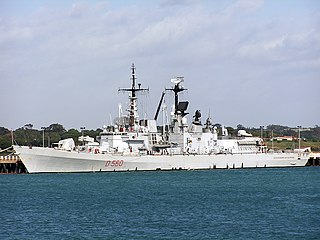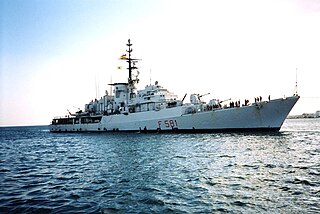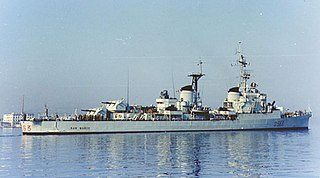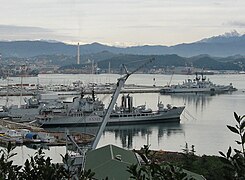
The Maestrale class is a class of frigates of the Italian Navy. The class is composed of eight vessels, all of which were built by Fincantieri S.p.A., Riva Trigoso, except for Grecale, which was built by Fincantieri S.p.A. – Muggiano, La Spezia.

The Italian Navy is one of the four branches of Italian Armed Forces and was formed in 1946 from what remained of the Regia Marina after World War II. As of August 2014, the Italian Navy had a strength of 30,923 active personnel, with approximately 184 vessels in service, including minor auxiliary vessels. It is considered a multiregional and a blue-water navy.

Giovanni delle Bande Nere was an Italian light cruiser of the Giussano class, which served in the Regia Marina during World War II. She was named after the eponymous 16th-century condottiero and member of the Medici family. Her keel was laid down in 1928 at Cantieri Navali di Castellammare di Stabia, Castellammare di Stabia; she was launched on 27 April 1930, and her construction was completed in 1931. Unlike her three sisters, the finish and workmanship on the vessel were not rated highly. She was sunk on 1 April 1942 by the British submarine HMS Urge.

The OTO Melara 76 mm gun, marketed as the OTO 76/62 Gun Mount, is a naval autocannon built and designed by the Italian defence company OTO Melara. It is based on the OTO Melara 76/62C and evolved toward 76/62 SR and 76/62 Strales.

Vittorio Veneto was a helicopter cruiser that served with the Italian Navy. Originally intended to be a class of two ships specifically designed for anti-submarine warfare (ASW), only Vittorio Veneto entered into service in 1969, its sister ship Italia being cancelled. Vittorio Veneto was placed into reserve in 2003 and decommissioned in 2006. This ship has the same general layout as the smaller Andrea Doria-class helicopter cruisers, but with two elevators in the flight deck and the hangar below, rather than with the hangar as part of the superstructure. It was named for the decisive Battle of Vittorio Veneto which ended World War I on the Italian front.

Caio Duilio was an Andrea Doria-class helicopter cruiser of the Marina Militare. Built by Navalmeccanica at Castellammare di Stabia, it was named after the Roman consul Gaius Duilius.

The Abukuma-class destroyer escort is the general-purpose destroyer escort of the Japan Maritime Self-Defense Force (JMSDF). It is the successor of the earlier Yūbari class. They are being replaced by the Mogami-class frigates.

The Audace-class destroyers were two guided missile destroyers built for the Italian Navy during the Cold War. An improvement of the Impavido class, these ships were designed for area air defence and also had a heavy gun armament. They were fitted with contemporary American radars and sonars, but also, as the next Italian ships, all the modern weapons made by Italian industry of the time, such as torpedoes, helicopters and guns. Also some indigenous radars were fitted.

The Durand de la Penne class are two guided-missile destroyers operated by the Italian Navy. The design is an enlarged version of the Audace class, updated with diesel and gas turbine CODOG machinery and modern sensors. Four ships were planned but the second pair were cancelled when Italy joined the Horizon project.

The T 47 class or Surcouf class were the first destroyers built for the French Navy after the Second World War. Twelve ships were built between 1955 and 1957. The ships were modernised in the 1960s and decommissioned in the 1980s, when they were replaced by the Cassard and Georges Leygues-class frigates. The class was authorised in 1949 and were designed as aircraft carrier escort vessels. Three were modified to become flagships, four became anti-air guided missile destroyers and five became anti-submarine destroyers. One member of the class survives, Maillé-Brézé as a museum ship at Nantes.

Caio Duilio is a destroyer of the Italian Navy. She and her sister Italian destroyer Andrea Doria form the Andrea Doria class; in turn these two ships, and the French vessels Forbin and Chevalier Paul, belong to the Horizon class. Caio Duilio is marked by hull number D 554 according to NATO classification.

Carabiniere was a frigate operated by the Italian Navy. Launched in 1967, the vessel served in the anti-submarine role during the Cold War until 1992. The ship was then recommissioned as a testing platform for new weapons systems, including Aster, finally retiring in 2008.
The following is the structure of the Italian Navy as of June 2020. It is considered a multiregional and a blue-water navy.

Audace(D 551) is the lead ship of the Audace-class destroyer of the Italian Navy.

Impavido(D 570) is the lead ship of the Impavido-class destroyer of the Italian Navy.

Intrepido(D 571) is the second ship of the Impavido-class destroyer of the Italian Navy.

The San Giorgio class was a class of two destroyers of the Italian Navy. They entered service in 1955, with the last one being decommissioned in 1980. Formerly Capitani Romani-class cruisers of the Regia Marina during World War II, they were rebuilt as destroyers during the Cold War. San Giorgio was the first to enter service in 1955 and was modified again from 1963 to 1965 to become a training ship until 1980. San Marco was scuttled by the Germans after the incomplete ship fell into German hands following the Italian Armistice. Following the war, the vessel was raised, rebuilt and renamed and entered service in 1956. San Marco served until 1971.

Audace was the lead ship of the Audace-class destroyers of the Italian Regia Marina. Commissioned in 1914, she served during World War I, participating in the Adriatic campaign and operating as a convoy escort until she sank after a collision in 1916.
Animoso was the second and final Audace-class destroyer of the Italian Regia Marina. Commissioned in 1914, she played an active role in the Adriatic campaign of World War I. Badly damaged by an accidental explosion in 1921, she was stricken in 1923.
Ardito was the lead ship of the Italian Ardito-class destroyers. Commissioned into service in the Italian Regia Marina in 1913, she served in World War I, playing an active role in the Adriatic campaign. Reclassified as a torpedo boat in 1929, she was discarded in 1931.



















